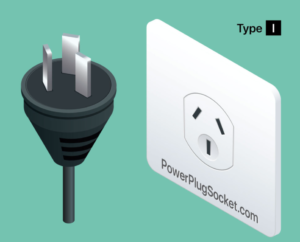KEY POINTS
- Australia and most local Pacific island nations use the same plug standard as New Zealand, so you don’t need to use an adaptor.
- However, if you’re travelling elsewhere in the world, you’ll need to purchase a suitable plug adaptor in order to use your electronic gadgets overseas.
- While most phones, laptops and portable tech can be used on overseas voltages, many other common household devices can’t. So, when travelling, always check to see if your electrical appliance can handle the local power voltage before use, to prevent damage.
What type of electrical plug does NZ use?

New Zealand uses the Type I plug and socket standard. Type I plugs have three flat pins, two of which are angled to form an inverted V. The other pin runs vertically underneath.
When looking directly at the pins, the angled one, top right, is for the active (hot or live) wire, which carries the current from the power source to the device.
The top left angled pin is for the neutral wire, which carries the current back from your device to the power source, completing the electrical circuit.
The bottom vertical pin is a ground/earth wire. This is a safety feature that provides a path for current to safely dissipate in the event of a fault or short circuit.
Does Australia use the same type of electrical plug as NZ?
Australia also uses the Type I plug and socket standard, and shares the same mains voltage: 230V. This means you don’t need an adapter to use NZ devices when visiting OZ.
Which other countries use the same electrical plugs as NZ?
Aside from Australia and New Zealand, other countries that use the Type I plug and socket standard and share approximate mains voltages include:
- Argentina
- China
- Fiji
- Papa New Guinea
- Samoa
- Tokelau
- Tonga
- Tuvalu
Which countries require the use of power plug adaptors?
Most countries use different electrical plugs to NZ, so if you’re visiting anywhere other than the few countries listed above, you’ll need to purchase a plug adaptor.
And you could need to use a voltage converter, too. Most modern tech devices, such as phones and laptops, are dual-voltage, meaning you’ll be able to use them wherever you’re visiting, as long as you have the correct plug adaptor.
However, other electrical appliances that you may want to take on your travels, such as hair dryers and straighteners, are usually designed specifically for the voltage in the country they’re sold in. So it’s always advisable to check if your device/appliance is dual-voltage before you use it overseas, to prevent it being damaged.
And while you can purchase travel voltage converters, they tend to be a lot more expensive than standard plug adaptors, so you might want to consider leaving your non-voltage compliant electrical gadgets at home.
Compare electricity providers with Canstar Blue
Finding affordable power involves shopping around. And to help you find the best value electricity retailer, Canstar Blue rates NZ power companies for customer satisfaction and value for money, see the table below for some of the results, or you can click on the button below for the full results of our survey.
Canstar Blue’s latest review of NZ power companies compares them on customer satisfaction. The table below is an abridged version of our full results, available here.
^ By clicking on a brand or 'details' button, you will leave Canstar Blue and be taken to either a product provider website or a Canstar Blue NZ brand page. You agree that Canstar Blue NZ’s terms and conditions apply (without limitation) to your use of this service,to any referral to a product provider from our website, and any transaction that follows. Canstar Blue may earn a fee for referrals from its website tables, and from sponsorship (advertising) of certain products. Payment of sponsorship fees does not influence the star rating that Canstar Blue awards to a sponsored product. Fees payable by product providers for referrals and sponsorship may vary between providers, website position, and revenue model. Sponsorship fees may be higher than referral fees. Sponsored products are clearly disclosed as such on website pages. They may appear in a number of areas of the website such as in comparison tables, on hub pages and in articles. Sponsored products may be displayed in a fixed position in a table, regardless of the product’s rating, price or other attributes. The table position of a sponsored product does not indicate any ranking, rating or endorsement by Canstar Blue. See How we are funded for further details.
Canstar Blue NZ Research finalised in June 2025, published in June 2025.
See Our Ratings Methodology
Compare electricity providers with Canstar Blue!
 About the author of this page
About the author of this page
Bruce Pitchers is Canstar NZ’s Content Manager. An experienced finance reporter, he has three decades’ experience as a journalist and has worked for major media companies in Australia, the UK and NZ, including ACP, Are Media, Bauer Media Group, Fairfax, Pacific Magazines, News Corp and TVNZ. As a freelancer, he has +worked for The Australian Financial Review, the NZ Financial Markets Authority and major banks and investment companies on both sides of the Tasman.
In his role at Canstar, he has been a regular commentator in the NZ media, including on the Driven, Stuff and One Roof websites, the NZ Herald, Radio NZ, and Newstalk ZB.
Away from Canstar, Bruce creates puzzles for magazines and newspapers, including Woman’s Day and New Idea. He is also the co-author of the murder-mystery puzzle book 5 Minute Murder.


Share this article